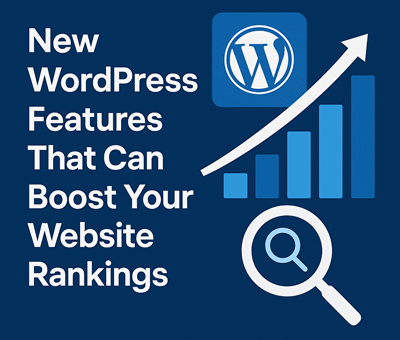With every new update, WordPress continues to evolve—not just as a content management system, but as a powerful SEO-friendly platform. If you’re looking to improve your website’s search engine rankings, staying up-to-date with the latest WordPress features is crucial.
In this blog, we’ll explore the latest WordPress features that can significantly enhance your website’s SEO performance and help you climb the Google rankings.
1. Improved Site Health Monitoring
The latest versions of WordPress include an enhanced Site Health tool. This built-in feature now gives you detailed insights into your site’s performance and security—two factors that indirectly affect your SEO.
Benefits:
-
Alerts you about outdated plugins/themes
-
Provides tips to improve site speed
-
Flags potential security issues
Action Tip: Regularly check your Site Health status under Tools > Site Health to keep your site optimized and secure.
2. Native XML Sitemaps
WordPress now comes with automatic XML sitemap generation, eliminating the need for third-party plugins.
Why it matters:
-
Helps search engines discover your content faster
-
Ensures better indexing of pages and posts
-
Supports custom post types and taxonomies
Action Tip: You can view your sitemap at yourdomain.com/wp-sitemap.xml and submit it to Google Search Console for better crawl visibility.
3. Block Editor Enhancements (Gutenberg)
The Gutenberg editor continues to get smarter. New improvements make it easier to create structured, SEO-friendly content with semantic HTML blocks.
SEO Advantages:
-
Headings (H1-H6) are easier to organize
-
Blocks encourage content hierarchy
-
Supports rich media and lazy loading
Action Tip: Use heading blocks properly (H1 for titles, H2 for sections) and include keyword-rich anchor text in buttons and links.
4. Lazy Loading for Images & iFrames
Now a default feature, lazy loading defers off-screen images and videos until they’re needed. This reduces initial page load time, which is a critical ranking factor.
Benefits:
-
Speeds up your site
-
Enhances mobile performance
-
Improves user experience
Action Tip: Ensure your theme supports this feature, or update it if necessary. Use WebP image formats for even faster loads.
5. Full Site Editing (FSE)
With Full Site Editing, you can now control every part of your site with blocks—header, footer, sidebar, etc. This ensures consistent design and structure, improving crawlability.
SEO Boosts:
-
Clean, minimal code
-
Easier to create responsive layouts
-
Better control over meta elements and headings
Action Tip: Explore block-based themes to make the most of FSE and keep your site layout both user- and search-engine-friendly.
6. Built-in Performance Improvements
Recent WordPress updates have improved core performance by optimizing queries, reducing database calls, and better handling of scripts and styles.
Result:
-
Faster page speed scores on tools like GTmetrix & PageSpeed Insights
-
Lower bounce rates
-
Better mobile usability
Action Tip: Update WordPress regularly and audit your site speed using tools like GTmetrix or Google PageSpeed Insights.
7. Better Accessibility Features
Accessibility is now a priority in WordPress updates. Features like keyboard navigation, ARIA labels, and screen-reader enhancements make your site more usable.
SEO Angle:
-
Accessible sites are favored by Google
-
Improved user experience boosts dwell time
-
Lower bounce rate
Action Tip: Use accessible themes and follow the WCAG guidelines to ensure your content is usable by everyone.
Final Thoughts
WordPress continues to add new features that not only enhance user experience but also align with Google’s evolving SEO standards. By keeping your site updated and leveraging these tools smartly, you can stay ahead of the competition and achieve higher rankings in search engine results.
Remember: SEO is not a one-time task. Make it a habit to explore new features with every WordPress update and optimize your site accordingly.


